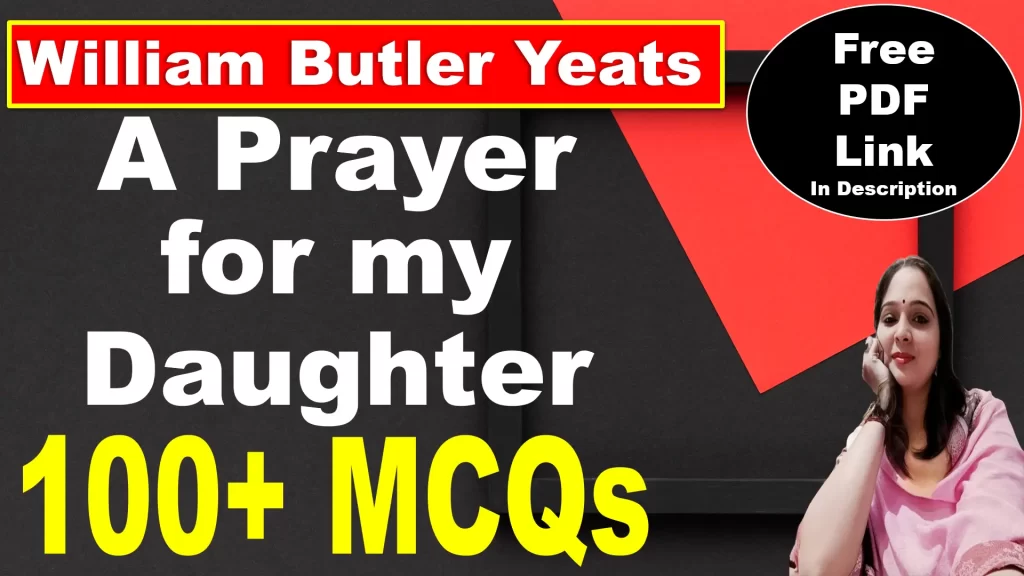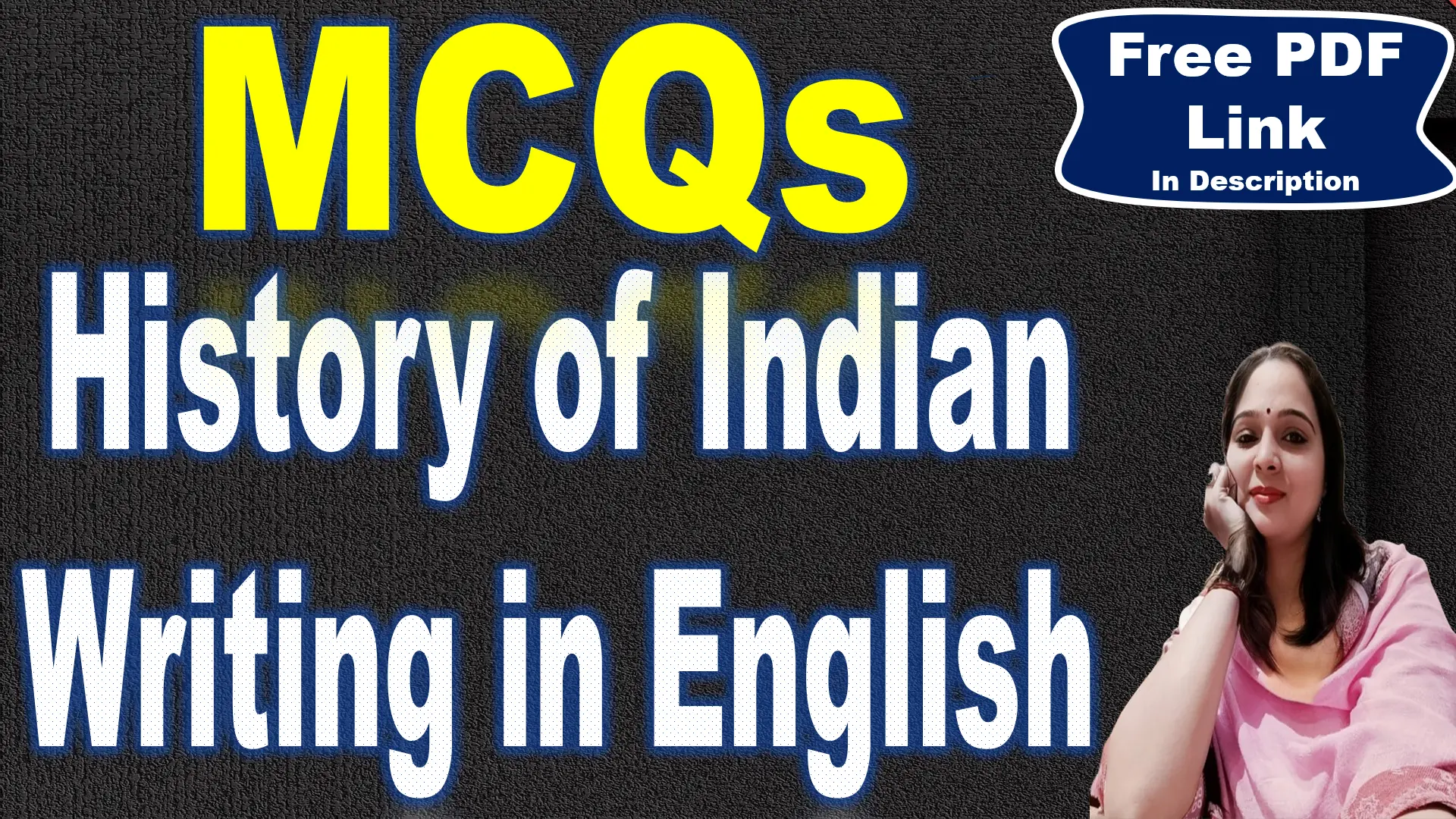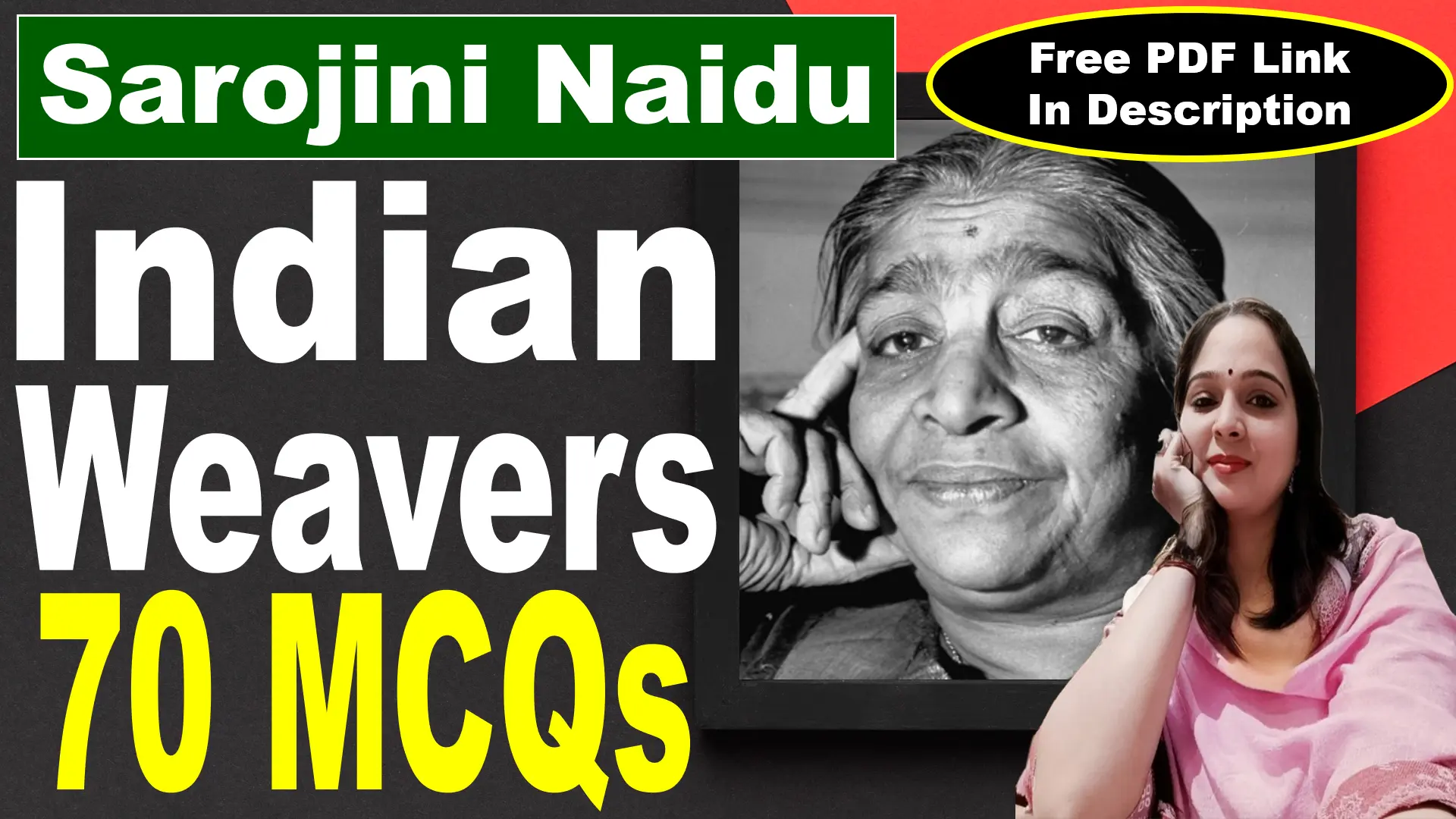
61. What role does the “bridegroom” play in Yeats’s vision for his daughter?
a) A source of wealth
b) A guide to a stable, traditional life
c) A figure of rebellion
d) A symbol of independence
Answer: b) A guide to a stable, traditional life
Explanation: He hopes her bridegroom brings her to “a house / Where all’s accustomed, ceremonious”. In “A Prayer for My Daughter,” Yeats envisions the bridegroom as someone who will provide his daughter with a stable, traditional life. The bridegroom is not just a romantic figure but a partner who will help anchor her in customs and ceremony, which Yeats values as a means of preserving innocence, beauty, and virtue. He hopes that through this marriage, his daughter will find security and groundedness in a world that seems increasingly chaotic and uncertain, marked by political turmoil.
62. What literary device is used in “every windy quarter howl”?
a) Metaphor
b) Simile
c) Personification
d) Onomatopoeia
Answer: c) Personification
Explanation: The phrase “every windy quarter howl” uses personification, a literary device where human qualities are attributed to non-human things. In this case, the wind is described as “howling,” which is a human-like action, giving the wind a voice or personality. This personification intensifies the sense of chaos and disturbance that surrounds the speaker, amplifying the feeling of unease that is present throughout the poem.
63. What does Yeats imply about “ceremony” in the final stanza?
a) It is oppressive
b) It fosters beauty and innocence
c) It is outdated
d) It leads to arrogance
Answer: b) It fosters beauty and innocence
Explanation: “How but in custom and in ceremony / Are innocence and beauty born?” Yeats implies that “ceremony” plays a crucial role in fostering beauty and innocence. He views ceremony not as a rigid or outdated ritual, but as a means of preserving tradition, order, and moral purity. Ceremony, for Yeats, symbolizes a structured life that helps maintain innocence and grace in a chaotic world. He sees it as essential for cultivating virtues like kindness, respect, and emotional intimacy, all of which he hopes for his daughter to embody in her life.
64. What is the overall tone of “A Prayer for My Daughter”?
a) Optimistic and cheerful
b) Anxious yet hopeful
c) Bitter and resigned
d) Angry and defiant
Answer: b) Anxious yet hopeful
Explanation: The overall tone of the poem is anxious yet hopeful. Yeats expresses his fears about the future, especially in relation to his daughter’s safety and well-being in a tumultuous world, but he also conveys a sense of hope. Despite the looming challenges and chaos surrounding her, Yeats’ hope lies in the virtues he wishes for his daughter: innocence, kindness, and a grounded, peaceful life. The tone reflects his deep love and concern, but also his belief that through tradition and virtue, his daughter can thrive.
65. In which year was “A Prayer for My Daughter” first published?
a) 1917
b) 1919
c) 1921
d) 1923
Answer: c) 1921
Explanation: “A Prayer for My Daughter” was first published in 1921, following the end of World War I and during the period of political upheaval in Ireland, specifically the Irish War of Independence. The poem was written in response to both personal and political concerns, reflecting Yeats’ anxieties about the future and his hopes for his daughter’s life in a turbulent world. The historical context of the time deeply influenced the themes of the poem.
66. In which collection did “A Prayer for My Daughter” originally appear?
a) The Wild Swans at Coole
b) Michael Robartes and the Dancer
c) The Tower
d) The Wind Among the Reeds
Answer: b) Michael Robartes and the Dancer
Explanation: “A Prayer for My Daughter” first appeared in Yeats’ 1921 collection Michael Robartes and the Dancer. This collection marked a transitional phase in Yeats’ poetry, where he moved from the symbolic, mystical style of his earlier works to more direct, personal expressions. The collection includes poems that reflect on themes of love, identity, and the personal and political struggles of the time.
67. What significant personal event inspired Yeats to write “A Prayer for My Daughter”?
a) His marriage to Georgie Hyde-Lees
b) The birth of his daughter, Anne
c) The death of a close friend
d) His move to Thoor Ballylee
Answer: b) The birth of his daughter, Anne
Explanation: Yeats wrote “A Prayer for My Daughter” in 1919, shortly after the birth of his daughter, Anne. This deeply personal event inspired him to reflect on the world his child would grow up in, and the poem expresses his hopes and anxieties for her future. His concerns about political instability, personal loss, and the influence of beauty on one’s life are all addressed in the poem, making it both a personal and political meditation.
68. In what year was Anne Yeats, the subject of the poem, born?
a) 1916
b) 1918
c) 1919
d) 1920
Answer: c) 1919
Explanation: Anne Yeats, the subject of “A Prayer for My Daughter,” was born in 1919. Her birth occurred during a time of significant political upheaval in Ireland, with the Irish War of Independence and the aftermath of World War I. Yeats wrote the poem as a reflection on his hopes for her future, amid the uncertainties of the time. The poem reveals his deep affection for her and his desire to shield her from the turmoil surrounding her.
69. What historical event was occurring in Ireland around the time Yeats wrote the poem?
a) The Easter Rising
b) The Irish War of Independence
c) The Irish Civil War
d) The Great Famine
Answer: b) The Irish War of Independence
Explanation: Yeats wrote “A Prayer for My Daughter” during the Irish War of Independence (1919–1921), a period of political turmoil and conflict in Ireland. The war, which ultimately led to the establishment of the Irish Free State, was marked by violence, division, and uncertainty. Yeats’ concerns about the future of his daughter are shaped by this historical backdrop, reflecting the unstable and chaotic environment that defined much of Ireland’s early 20th-century history.
70. Where was Yeats living when he composed “A Prayer for My Daughter”?
a) Dublin
b) London
c) Thoor Ballylee
d) Sligo
Answer: c) Thoor Ballylee
Explanation: Yeats was living at Thoor Ballylee, a tower in County Galway, when he wrote “A Prayer for My Daughter.” Thoor Ballylee was a place of personal significance for Yeats, serving as both a home and a retreat for his creative work. The peaceful, rural setting contrasts with the political and social unrest that was occurring in Ireland at the time. Yeats often drew inspiration from his surroundings, and the tranquility of Thoor Ballylee may have influenced his reflections on innocence, peace, and tradition in the poem.
71. Which literary movement is W.B. Yeats most closely associated with?
a) Romanticism
b) Modernism
c) Realism
d) Victorianism
Answer: b) Modernism
Explanation: W.B. Yeats is most closely associated with Modernism, a literary movement that emerged in the early 20th century as a reaction to the disillusionment caused by World War I, rapid industrialization, and political upheavals. Modernist writers like Yeats explored themes of fragmentation, individualism, and the search for meaning in a changing world. His poetry blends both traditional forms and modernist innovations, dealing with complex themes of identity, national struggle, and the passage of time, which align with the broader Modernist movement.
72. What was Yeats’s role in Irish culture beyond poetry at the time of writing this poem?
a) A playwright and co-founder of the Abbey Theatre
b) A political revolutionary
c) A journalist
d) A university professor
Answer: a) A playwright and co-founder of the Abbey Theatre
Explanation: Beyond his poetry, Yeats was a prominent playwright and co-founder of the Abbey Theatre, Ireland’s national theater, established in 1904. The Abbey Theatre played a key role in the Irish Literary Revival, a movement that sought to promote Irish culture and literature. Yeats used the theater as a platform for his nationalistic ideals, and his works helped shape the modern Irish identity. His involvement in the theater was crucial in fostering a sense of Irish pride and independence, which was especially significant during Ireland’s political struggles.
73. Which earlier poem by Yeats shares thematic similarities with “A Prayer for My Daughter”?
a) “The Second Coming”
b) “Sailing to Byzantium”
c) “The Lake Isle of Innisfree”
d) “Easter, 1916”
Answer: a) “The Second Coming”
Explanation: Yeats’s “The Second Coming” shares thematic similarities with “A Prayer for My Daughter” in terms of the anxiety and uncertainty about the future. In “The Second Coming,” Yeats expresses a vision of a chaotic and apocalyptic world, mirroring the tumultuous political and social climate of his time. Similarly, “A Prayer for My Daughter” reflects Yeats’s concerns about the future of his daughter in a world full of instability, reflecting his anxiety about societal collapse and the potential dangers ahead for future generations.
74. What personal influence might have shaped Yeats’s views on beauty and opinion in the poem?
a) His unrequited love for Maud Gonne
b) His friendship with Ezra Pound
c) His study of Irish folklore
d) His political career in the Irish Senate
Answer: a) His unrequited love for Maud Gonne
Explanation: Yeats’s unrequited love for Maud Gonne, an Irish revolutionary and actress, profoundly influenced his views on beauty and opinion, particularly regarding the theme of beauty’s dangers. His idealization of Gonne, combined with the emotional turmoil of their relationship, likely shaped his skepticism about the superficial aspects of beauty. Yeats often explored the tension between the external and internal in his poetry, critiquing the destructive power of idealized beauty and its ability to overshadow more important personal qualities.
75. What poetic device is evident in the phrase “the storm is howling” in the first stanza?
a) Metaphor
b) Personification
c) Simile
d) Alliteration
Answer: b) Personification
Explanation: The phrase “the storm is howling” uses personification, a literary device where non-human entities or natural forces are given human characteristics. In this case, the storm is described as “howling,” a behavior typically associated with animals or humans, to emphasize the ferocity and violence of the storm. This technique amplifies the sense of chaos and disruption in the poem, reinforcing the metaphor of the storm as a symbol of the external turmoil that Yeats feels threatens the safety of his daughter’s future.
76. The line “dancing to a frenzied drum” uses which device to convey the chaos of the future?
a) Imagery
b) Onomatopoeia
c) Hyperbole
d) Simile
Answer: a) Imagery
Explanation: “Dancing to a frenzied drum” is an example of imagery, as it vividly describes an unsettling scene that evokes a sense of wild, uncontrollable motion and noise. The image of frenzied dancing to a chaotic drumbeat creates a visual and auditory representation of the chaos Yeats fears the future holds. This use of imagery helps the reader sense the instability and confusion that Yeats imagines his daughter will have to navigate as she grows up in a turbulent world.
77. What device is used in “murderous innocence of the sea” to highlight nature’s dual nature?
a) Oxymoron
b) Metaphor
c) Enjambment
d) Symbolism
Answer: a) Oxymoron
Explanation: The phrase “murderous innocence of the sea” is an oxymoron, which combines two contradictory terms to highlight the paradoxical nature of the sea. The sea is described as both “innocent” and “murderous,” suggesting that while nature can appear pure, uncontaminated, and beautiful, it also has the capacity for great destruction. This oxymoron reflects Yeats’ belief in the duality of nature, where beauty and danger coexist, symbolizing the unpredictability of life and the conflicting forces that shape the world.
78. What does the poet compare the storm to in the first stanza?
a) A cradle rocking gently
b) A Gregory’s wood
c) A howling beast
d) A dancing shape
Answer: c) A howling beast
Explanation: The first stanza begins: “Once more the storm is howling, and half hid / Under this cradle-hood and coverlid / My child sleeps on. / There is no obstacle / But Gregory’s wood and one bare hill / Whereby the haystack- and roof-levelling wind, / Bred on the Atlantic, can be stayed.” The storm is described as “howling” and powerful, capable of “haystack- and roof-levelling,” suggesting a fierce, wild force.
79. What device does Yeats employ in “a crazy salad with their meat” to suggest disordered choices?
a) Simile
b) Metaphor
c) Personification
d) Irony
Answer: b) Metaphor
Explanation: In the phrase “a crazy salad with their meat,” Yeats uses a metaphor to suggest disordered or irrational choices, particularly in the context of women’s decisions driven by superficial beauty. The metaphor of a “crazy salad” implies that their choices are mixed, erratic, and without clear purpose or sense. By juxtaposing an unusual salad with meat, Yeats emphasizes the chaotic nature of decisions that prioritize beauty over deeper qualities such as wisdom and kindness.
80. How does the phrase “rooted in one dear perpetual place” reflect the poet’s hopes for his daughter’s life?
a) Metaphor
b) Irony
c) Personification
d) Onomatopoeia
Answer: a) Metaphor
Explanation: The phrase “rooted in one dear perpetual place” appears in the eighth stanza: “And may her bridegroom bring her to a house / Where all’s accustomed, ceremonious; / For arrogance and hatred are the wares / Peddled in the thoroughfares. / How but in custom and in ceremony / Are innocence and beauty born? / And rooted in one dear perpetual place.” Here, Yeats expresses his wish for his daughter to live a stable, virtuous life, grounded in tradition and a single, cherished home—contrasting the chaotic, hateful world outside.
Metaphor is the key device. “Rooted” compares his daughter’s life to a plant or tree fixed firmly in soil, implying stability, growth, and enduring connection to one place, without using “like” or “as.” It reflects his hope for her to thrive quietly and securely, away from turmoil.





